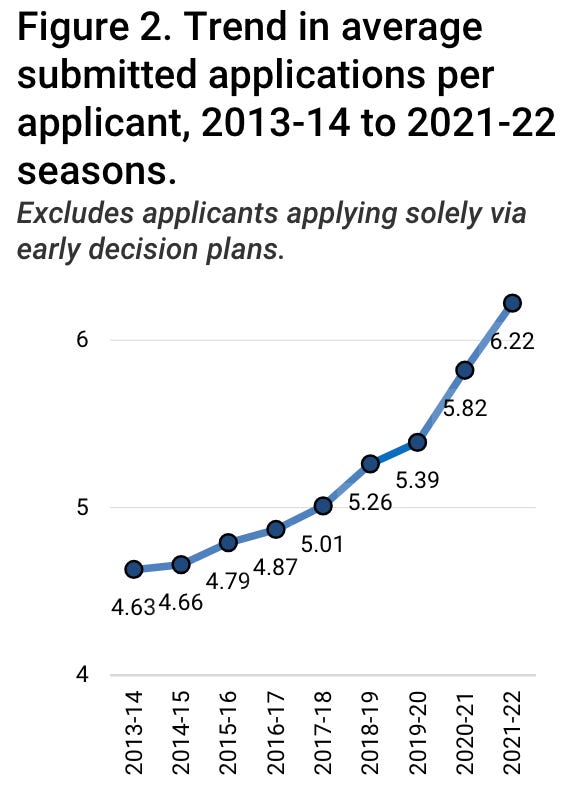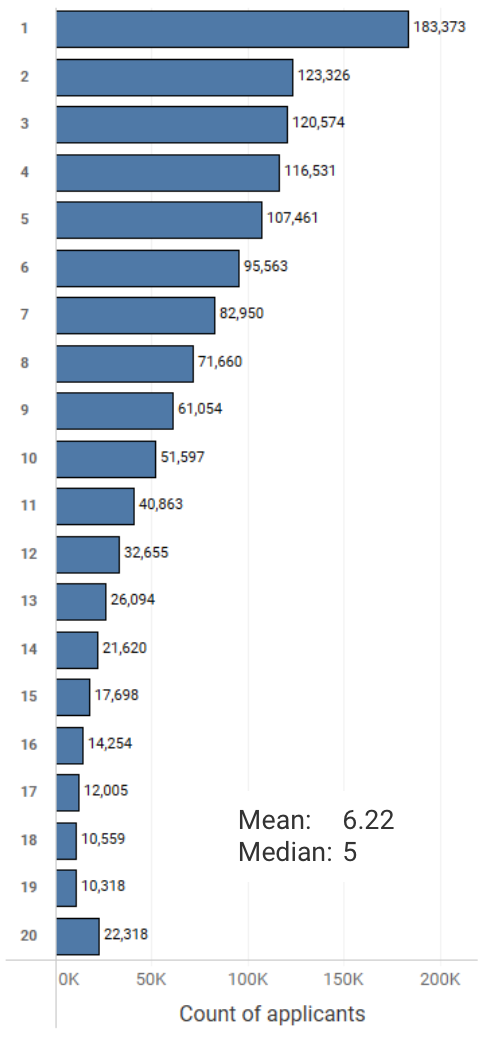How Many Colleges Should You Apply To?
Find out how to create a balanced college list and apply to the right number of schools.
Today’s College Application Guy article is in a facts and feelings format. Some common college admissions questions don’t have a single, straightforward answer. I present a bit of data (facts) to provide needed context, and then outline my point of view (feelings).
My Answer: The composition of your list is more important than the number. Most students can reach sufficient composition (balance/fit) at 5-10 schools.
FACTS - How Many Colleges Should You Apply To?
“Since 1975, Common App has strived to remove barriers, to reduce the stress and burdens on students and their families from multiple college applications, and to create greater access to higher education opportunities for all students by creating and innovating a single, shared application for college admission.” (link)
One of the primary goals of the Common App since its inception has been to reduce friction. The entire concept—a single, standardized “form” for admissions that is completed once and sent by students to multiple schools—rests on the assumption that a student will choose to apply to more than one university.
But just how many colleges should you apply to?
According to data from the Common Application:
The average number of applications per applicant has been increasing. In 2013-2014, the average was 4.63 applications. In 2021-2022, the average was 6.22.
The proportion of applicants applying to more than ten members has roughly doubled, from 8% to 17%, between 2014-15 and 2021-22.
Perhaps not surprisingly, a minority of applicants applying to many schools skews the data. One third (33.5%) of the applicants applying to the maximum of 20 member institutions were international students.
What’s been driving the increase? The Common App research team says it best:
“High-volume application behavior is first and foremost a phenomenon of selective college admissions.”
In other words, it has become much more difficult to gain acceptance to certain colleges, and with admittance uncertainty—even for extremely well-qualified applicants—students are hedging bets by applying to more schools.
It’s also worth noting that the Common App limits the number of applications to 20. Students can obviously circumvent this by applying directly to member institutions and/or applying to schools and systems that are not members of the Common App (e.g. Apply Texas, UC System, etc…).
Elsewhere, you can find a range of advice:
The College Board (makers of SAT and AP exams) suggests 5 - 8 applications.
US News & World Report notes that “experts disagree on a specific number,” with opinions ranging from 4-15.
Plenty of Reddit threads suggesting students should apply to more and more schools.
FEELINGS - How Many Colleges Should You Apply To?
Most important is to ensure your application list gives you adequate coverage across a range of elements:
1/ Likelihood of acceptance
2/ Cost (incl likelihood for receiving financial aid)
3/ Fit against other common criteria (size, location, your major, etc…).
Applying to 5 - 10 schools should be appropriate to achieve this for just about every student.
There is such a thing as applying to too few schools, and doing so limits your potential upside. Michael Luca, a business professor at Harvard, makes this case.
Applying to a sufficient number of schools increases the odds you’ll apply to a broader range of colleges. A broader range of colleges means more chances you’ll find a school where you’ll be accepted, happy to attend, do your best work, and be rewarded (cost vs. return on your investment over the long run).
Conversely, there is such a thing as applying to too many schools.
“If everything is important, then nothing is.” —Patrick Lencioni
If you haven’t done the deliberate work to narrow and focus your efforts, you may not yet know what factors are most important to you. If this is you, your first order of business is to define that criteria, and then aggressively triage your list to match. This should bring your application list back down to a more manageable number.
The justification I most often hear for why it’s OK to apply to a dizzying number of colleges is that the student is trying to maximise their chances of admission at highly selective institutions. I urge you to reject this.
For one, you can still apply to selective institutions and have a balanced list, all within the space of 10 applications. The two options aren’t mutually exclusive.
For another, highly selective institutions are very different from each other, sharing little in common other than their inclusion on someone’s these-are-the-highest-ranked-schools list. Is it likely that your “best fit” school is any of the Ivy League schools (8 schools), or a particular one (or two)? Is it likely that your “best fit” school is any of Stanford, Cal Tech, Washington University in St. Louis, Tulane, Amherst, Carnegie Mellon, Duke, UCLA, University of Michigan, NYU… ,or a particular few?
With a suggested maximum of 10 applications, what you can’t do is bulk-apply to any and all selective institutions, hoping just one will give you an acceptance. You have to be more choosy. But being choosy is good! It gives you permission to be more specific about what you want, including, perhaps, applying early decision or restrictive early action to one or more of these institutions.
Last, I want to close by calling attention to another important element of how many schools you apply to: where you actually want to go. With so much focus on the quantitative (will my GPA get me in?, what’s the acceptance rate?, what’s the cost?, etc.), we can sometimes lose sight of the qualitative, e.g., do I actually see myself attending this school?
It sounds obvious, but you only want to apply to schools you would be excited to attend, if accepted. For every school that is on your list, ask yourself: if school X is the only school you get admitted to, would you be happy to attend? If the answer is yes, keep it. If the answer is no, remove it.
Is it a failure to not get into any school where you’ve applied? Yes, it means your list composition was incorrect. It's equally unfortunate if you get accepted to a school on your list but have no interest in attending. Both situations can be avoided by applying to 5-10 schools that provide sufficient balance and fit.



